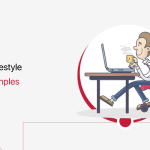
It’s easy poking fun at archaic websites from the 90s when lecturing about bad site design. But let’s be honest, no elite business has one that old. The Internet has been going for just 30 years but the standards for exceptional webpages are heightening at an incredible rate. In fact, numerous design applications from only three years ago have already been swept under the rug and replaced with the new.
With mobile searches on the rise websites have become the signature of all businesses and first point of contact for many visitors. If you lack one or haven’t revamped it in the last couple of years, there’s a good chance you’ve been eclipsed by competitors without even realising it.
Moreover, the abundance of low-cost website builders and cheap development options makes setting up a webpage look like a breeze. But sadly, an eye-grabbing webpage is far from synonymous with an effective one.
So let’s go through visual examples of big brands taking advantage of the latest web design trends to discover exactly how to outperform.
Be engaging but not distracting
No doubt thanks to lighting-fast internet speeds and on-demand services, humans can’t help skimming through content – especially on text-heavy websites – for instant gratification. It sounds like every business’ nightmare but look closely at how industry-leading websites, such as HSBC’s, have evolved to navigate the problem.

HSBC’s website has changed a lot in three years. Photo credit: Nerd Cow
For starters, the whitespace border’s increased size makes content much easier for visitors to focus on and read. Secondly, improved colour contrast and font weights results in everything being easier on the eye, with more imagery teasing what’s to come meaning more enticing content to click. Making spectators’ lives easier is the name of the game and despite more pictures and a thicker border, HSBC’s current site actually packs more information than 2016’s. It doesn’t bloat its length and makes content much more engaging.
With gradual tweaks over time, the bank transformed its website with a content-first approach and invaluable analytics about user behaviour – the core of website building professionals like Nerd Cow, the web agency. It goes to show what a difference just one and a half years can make.
Meet the mobile demand
In July 2018 Google announced mobile page speed as a ranking factor for its search engine, responding to the global trend of increasing mobile traffic. You might be familiar with how to achieve such mobile-optimised web design but 2019’s already doubled down on what you know.
The first pages using Google’s Accelerated Mobile Pages (AMP) project, for example, started appearing in 2016. But only two years later an alternative from a Google employee, Progressive web applications (PWAs), grew in popularity. Fundamentally, PWA lets HTML websites act as Android and iOS applications.
With limited access to some mobile device functionalities, PWAs aren’t replacing apps just yet. However, established brands like Forbes have seen excellent results from their implementation.
Immersion is better than engagement
We knew videos increase engagement and conversion rates as early as 2010. But recent years brought several subtle yet astounding ways to not only make your website engaging but immersive. For instance, as people fell in love with asymmetrical layouts and organic appearances, web design was released from the shackles of basic, linear formats.
With mobile-first approaches and technologies like PWA, simple, minimalist iconography has been unleashed ondesktop websites to streamline user experiences. Take TripAdvisor as a case in point. Although the company’s August 2018 web design was barely a year old, one year later a new implementation brought massive improvements to its usability.
![]()
The one-year transformation of TripAdvisor’s website. Photo credit: Nerd Cow
Get animated
Last but not least, intriguing animations can and should be naturally incorporated into web design. The site of Your Plan, Your Planet – Google’s initiative for a healthier world – is a textbook example. Its animations don’t distract but create an excellent, engaging prelude to a website dripping with action that guides users through a journey, rather than being unnecessarily decorative.

Google knows how to keep it simple. Photo credit: Nerd Cow
The rapid pace of change in web design and development tech makes it impossible for businesses to take a back seat. Keeping up with modern practices is quite simply essential for survival.
However, even though some components advance every year, you don’t need a new website every 12 months. But if it hasn’t been touched up in the last couple of years, giving it treatment with the very latest in web design is almost guaranteed to be a good investment.
[“source=elitebusinessmagazine”]











